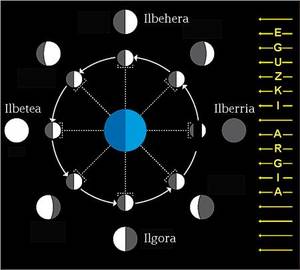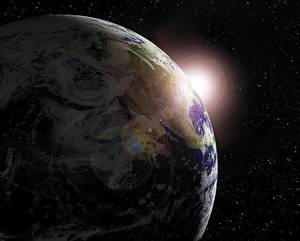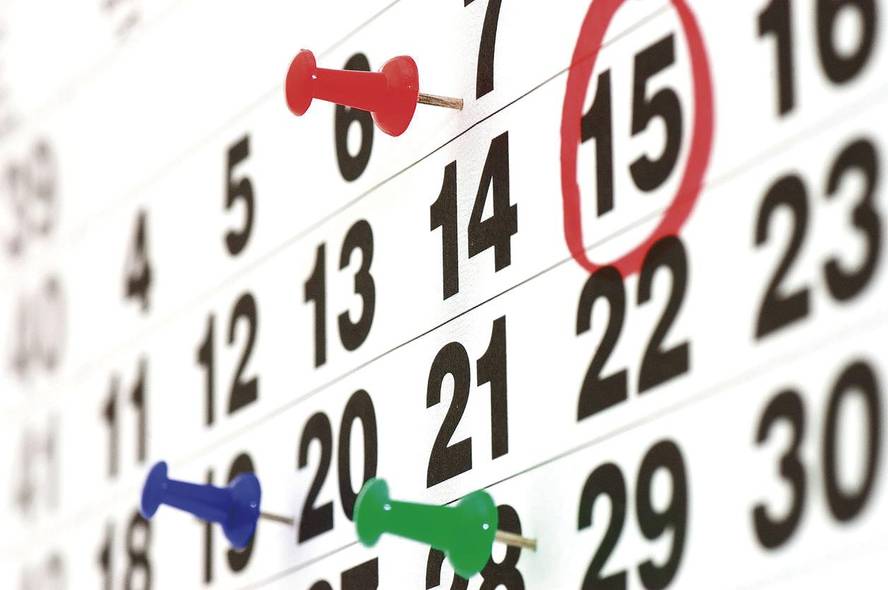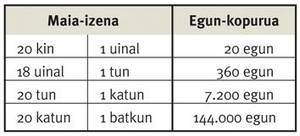Is it worth the year 3200 being biannual?
We have counted in different ways the number of days missing to reach a specific day. About 13,000 years ago, the humans of Cro-Magnon, to count the days between the first frost of winter and spring, had full moons; the prisoners had striped the number of days missing to leave the prison and be free; and they count the time that the children have to sleep to get to Olentzero. Based on the stages of the Moon, with stripes or the number of duels to be made as a unit, they are examples of a calendar that we all wear hanging on the wall, above the table or kept in the purse.
First calendar: Based on the stages of the Moon
For a long time, the obsession for measuring time comes to the human being. In times when we are able to measure nanosegunds (10 -9 seconds) and femtoseconds (10 -15 seconds), perhaps we find strange the journey of man in search of a specific calendar, but so it has been: the concrete and useful calendar has long been one of the most important challenges of the human being.

Although not all calendars of ancient times work the same way, they do have several common features. For example, most calendars are cyclical, that is, once a period is completed, they are repeated. Most of them are expressed in a circular form, since in ancient cultures they represented the firmament as disc, circle or sphere. This sphere was divided into lunar or sun months and the sky was distributed in 360 days a year or 360 degrees.
Astronomers of the Stone Age observed the periods of the Moon, as they realized that they could count the nights between the moments of the full, semi-solid, and totally dark Moon, and that they were repeated. Thus, some anthropologists consider that the calendar of the first that the human being used is the one formed by several notches made in an eagle bone, formed by a regular impression of different groups of similar symbols.
The moon needs about 29 and a half days (29,5306 days) to pass from the moon to the crescent moon, from the crescent moon to the full moon, from the moon to the waning fourth and from the moon to the waning fourth. Twelve full cycles of the Moon cover approximately the four seasons of the year, which formed what the societies of that time already knew as a year. Greeks, Jews, Chinese... used the lunar year, composed of 12 months of 29 and a half days, with a total of 354 days.
However, those who had a calendar based on lunar periods did not take long to realize that their year had some error, since in their calendar they are 8 years enough for the beginning of spring to occur at the beginning of the summer of their calendar, and thus, in 16 years, the beginning of summer coincided with the beginning of winter. To correct the error detected in the lunar year, the Greeks added 90 days in their calendar every 8 years, the Jews added a lunar month every 3 years and the Chinese mathematicians said that every 19 years they had to add 7 lunar months.
From the moon to the solar year
Sumer a.C. XXI. In the twentieth century we were in a year of 360 days, consequence of the rounding of the lunar month at 30 days. The Sumerian system was based on numbers 6 and 60. The multiplication of both numbers gives 360, and that number is still the one we use to distribute the cymbate or any circular plane. The Babylonians inherited the numbering system of the Sumerians and distributed the day 24 hours. Although the reason is not known, it seems to be a number related to the zodiac and that it brought him his astrological beliefs.

The solar year is the duration of the Earth's translation movement around the Sun, comprising 365,242190 days. About 6,000 years ago, the Egyptian corrected the error of the lunar year and took the solar year the first civilization. His calendar had 12 months of 30 days and 5 additional days. These five additional days became days of gods Osiris, Isis, Horus, Neftis and Set. While it is a mystery how the Egyptians made such a good approximation to the solar year, the most credible explanation is found in the Nile River: From the end of June to the end of October there were floods in the Nile River, which left a good soil for the harvest from October to February, so from February to the end of June an abundant harvest was collected in the lands adjacent to the river. Therefore, the inhabitants of the area should only count the days between a flood and the following to calculate the duration of the solar year. Egyptian astronomers also realized that the solar year was a fourth longer day of the calendar they themselves had, and that the year C. In the year 238 the duration of the solar year was established in 365 1/4 days.
But the Egyptians were not the only ones who used the 365 day calendar. The Mayans used 3 calendar systems, in one of which the duration of the year was 365 days. One of the calendars used by the Mayans is the so-called civil calendar ( haab ), the second is the so-called sacred calendar ( tzolkin ) and the third is the so-called long story. The Haab calendar has 18 months of 20 days and a month of 5 days, with a total of 365 days. It seems that the Mayans also knew that the length of the year was 365 1/4 days, although their calendar did not take into account the fourth day. The TZOLKIN calendar has 260 days and the long account system is based on 360 day drives, using the tun unit and number 20. For them the batkun is a time interval of 144,000 days, and multiplying the batkun by 13 get what is called long cycle, with an approximate duration of 5.130 years. They believed that, after a long cycle, until then it disappeared, giving way to a new world. On 21 December 2012, its last cycle ends, a. C. C. Started around 3114. Although it is not known with certainty, the Mayas gave the length of their year based on astronomical observations.
Our calendar: Gregorian calendar
At present, the calendar we use in most of the world is Gregorian, the XVI. Implanted in the eighteenth century by Pope Gregory XIII. Its objective was that the duration of the year of this calendar was as close as possible to that of the solar year. The Gregorian calendar is the solar calendar: Composed of 365 days and 12 months, it includes an additional day in the biennia. A year is biyear when it is multiple of four numbers. The exception are the years that are multiples of 100, which are only great when they are multiples of 400. For example, 1700., The years 1800 and 1900 are not leap years, but 2000 is two-year. Gregorian calendars Julius Caesar. It replaced the Julian calendar established in the year 45. The main difference between them is that in the Julian calendar every year were multiples of number 4. The year of the Julian calendar had an average of 365.25 days. In the Gregorian calendar, on the other hand, since it is not 3 years from 4 to 3 years multiple of 100, in a cycle of 400 years, instead of 100 years, there are 97 years of visas, which means 400 x 365 + 97 = 146.097 days. This gives us a year of 146,097/400 = 365,2425 days of average duration. Therefore, the Gregorian calendar is closer to the solar year than the Julian calendar.

Around the 1,600 years that the Julian calendar had an accumulated error of about 10 days with respect to the Gregorian calendar (and also with respect to the solar year), that is, 10 days later. To correct this error, when the Gregorian calendar was established, on October 4, 1582, of the Julian calendar, it followed on October 15, 1582, of the Gregorian calendar. Catholic countries, such as Spain, Portugal and Italy, immediately approved the Gregorian calendar.
However, the Gregorian calendar does not give an exact duration of the solar year, with a difference of 3.1·10 -4 days. That is, the Gregorian calendar introduces an additional day to the solar year every approximately 3.225 years. Can we think of another calendar that reduces the error of this calendar?
The duration of the Gregorian calendar can be calculated as follows:
Since the year of the Gregorian calendar is longer than the solar year, for example, a few years of visa can be removed to get closer to the duration of the solar year. For example, if we subtract the condition of bisyear from the multiples of 3,200, the duration of the year would be:
That is, if the bisaño is multiple of 4, but it is only multiple of 100 if it is multiple of 400, but it is not multiple of 3.200, we have a calendar that approaches better to the solar year. It is not uncommon for the number 3,200 to appear, since, as has been said above, the Gregorian calendar includes an additional day every 3,225 years.
To finish...
In the Gregorian calendar, this year is 2014; in the Korean calendar, 4347a; in the Mayan calendar, the 2nd year of the new period; in the Chinese, the year of the horse... The goal of all is to get as close as possible to the solar year. If the solar year were a normal number, everything would be easier and we would not need visas. Although every 3,200 years the accuracy of the Gregorian calendar is improved by eliminating a day, it is not necessary to do so, since in that period there is nothing to put an error of a day, and in that period the cycles of the Sun, the Earth, etc.
We will not be those who will modify the Gregorian calendar that has not undergone changes since we had established it, we will stop working on cycle changes. Who knows, perhaps the duration of the solar year will be 365 specific days, which will facilitate the tasks of preparing the calendar.









